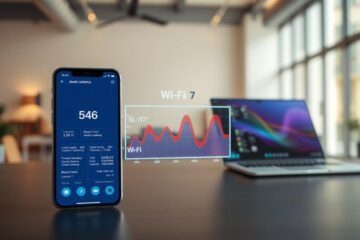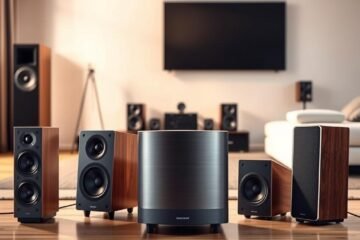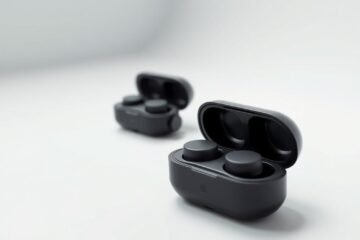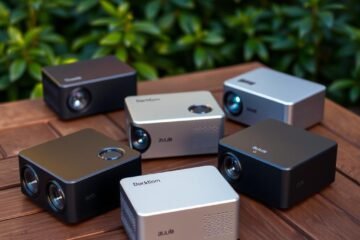Nearly 1 in 5 Americans will try smart audio eyewear this year. This shows audio glasses are becoming a common tool. You can choose from simple Bluetooth shades to advanced ai audio glasses with AR displays and more.
This guide will help you find the top audio glasses for Fall 2025. We’ll compare open-ear audio with bone-conduction and discuss sound quality and AI features. You’ll learn about brands like Ray-Ban Meta, Amazon Echo Frames, Soundcore Frames Wander, Oakley Meta Vanguard, Solo AirGo 3 and Lucyd Lyte Moonbeam.
Whether you need wireless audio glasses for running or stylish ones with great sound, we’ve got you covered. This article will help you make an informed choice.
Quick Comparison — Best Audio Glasses (Fall 2025)
| Pick | Model | Weight | Battery | Mics | IP | AI | Lenses | Controls | Price | Actions |
|---|---|---|---|---|---|---|---|---|---|---|
| Best Overall | Ray-Ban Meta Smart Glasses (Gen 2) | ~38 g | ~4–6 hrs | Beamforming | Splash | Meta AI / Siri | Polarized, Rx | Tap + Voice | $299 | Detail |
| Best for Calls | Amazon Echo Frames (3rd Gen) | ~36 g | ~5–6 hrs | 4-Mic + Wind | Splash | Alexa | Polarized / Blue-light / Rx | Tap + Voice | $249 | Details |
| Best Budget | Soundcore Frames Wander | ~33–40 g | ~4–6 hrs | Dual | Light splash | Siri / Google | Polarized, Interchangeable | Tap | $79–$99 | Details |
| Best for Workouts | Oakley Meta Vanguard | Sport-light | ~5 hrs | Dual | Sweat/Splash | Siri / Google | Shield, Polarized | Tap | $159+ | Details |
| Best for Small Faces | Solos AirGo 3 | ~34–36 g | ~5–6 hrs | Dual / Beamforming | Splash | Siri / Google | Modular, Rx | Tap + Voice | $179+ | Details |
| Best Style/Rx Variety | Lucyd Lyte 2.0 — Moonbeam | ~28–32 g | ~6–7 hrs | Dual | Splash | Siri / Google | Polarized, Transitions, Rx | Tap | $149+ | Details |
Editor’s Picks — Best Audio Glasses
Our six favorites for open-ear sound, clear calls, comfort, and smart features. Updated for Fall 2025.
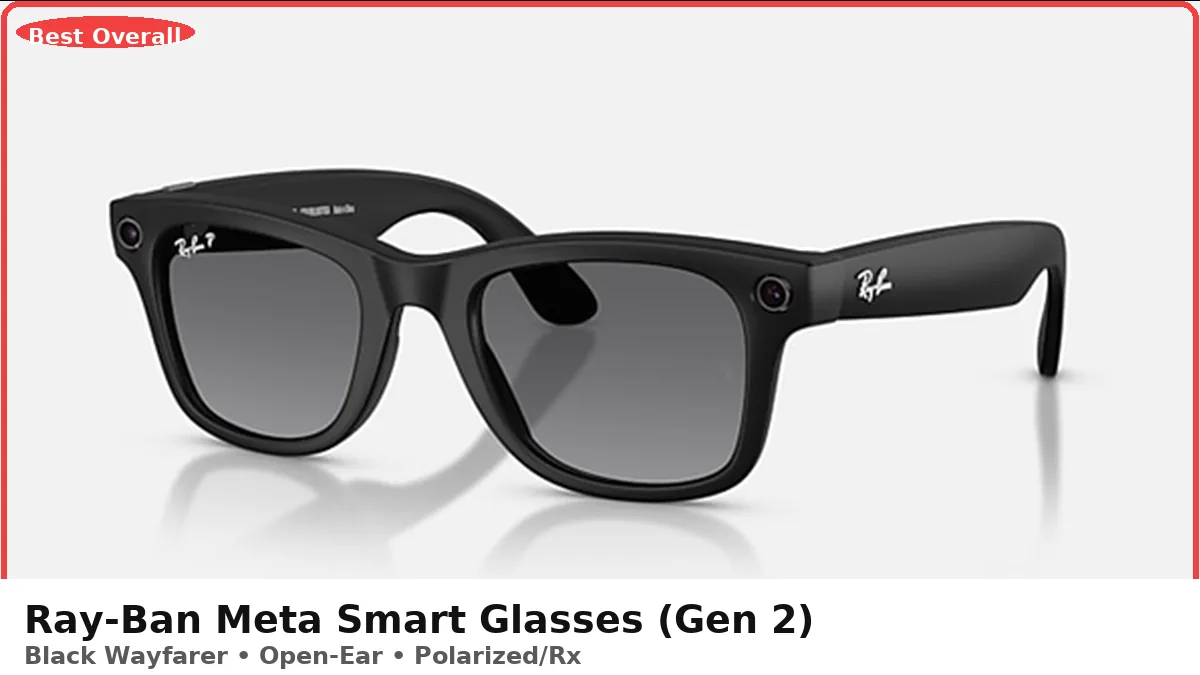
Ray-Ban Meta Smart Glasses (Gen 2)
- Great hands-free features
- Stylish frames & lenses
- Solid app controls
- Bass limited vs earbuds
- Some sound leak at max
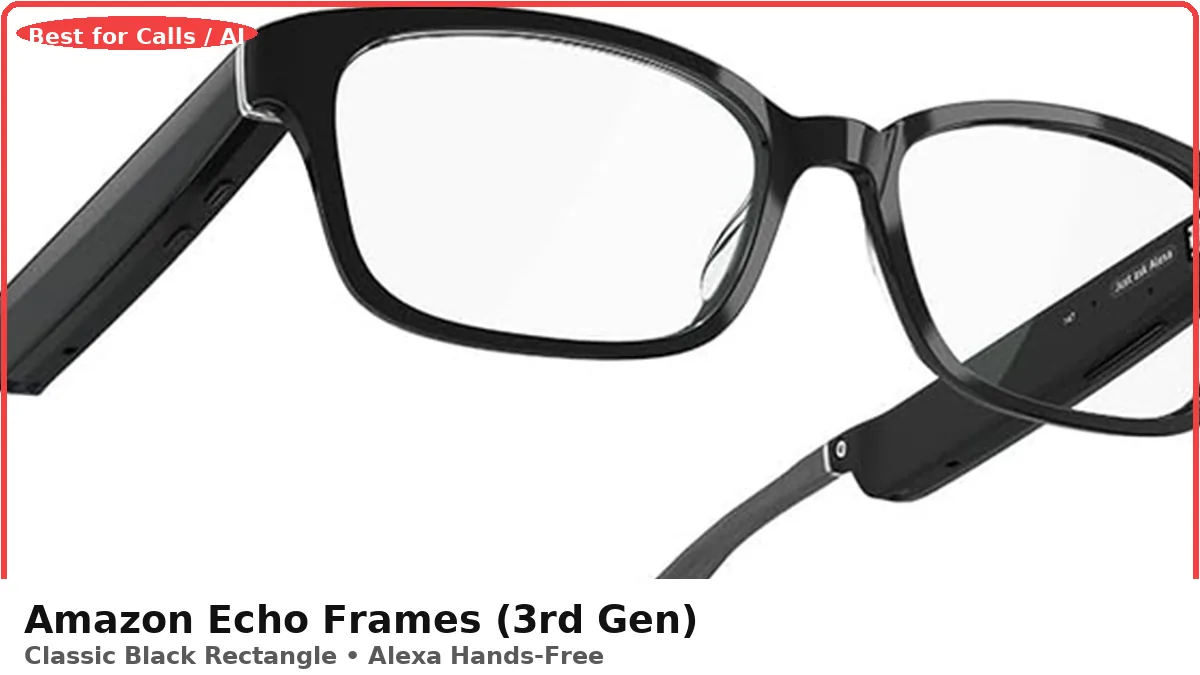
Amazon Echo Frames (3rd Gen)
- Excellent voice control
- Clear call quality
- Comfortable daily wear
- Average bass
- No charging case
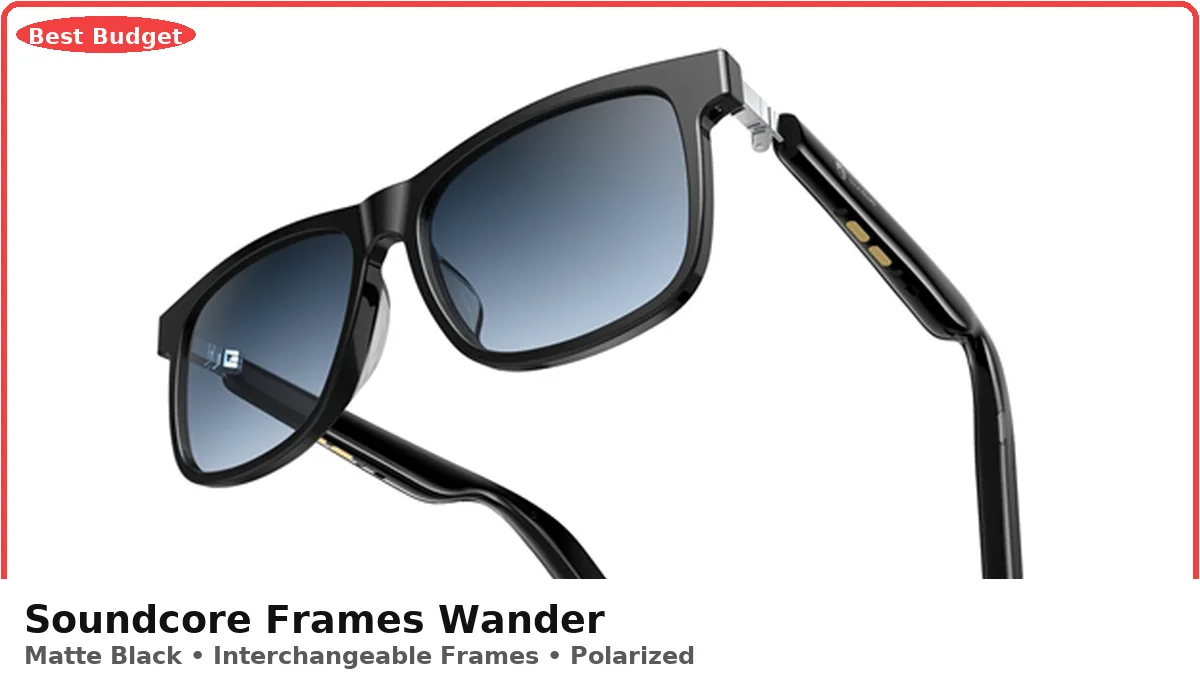
Soundcore Frames Wander
- Great value
- Swappable fronts
- Stable connection
- Average wind handling
- Shorter battery
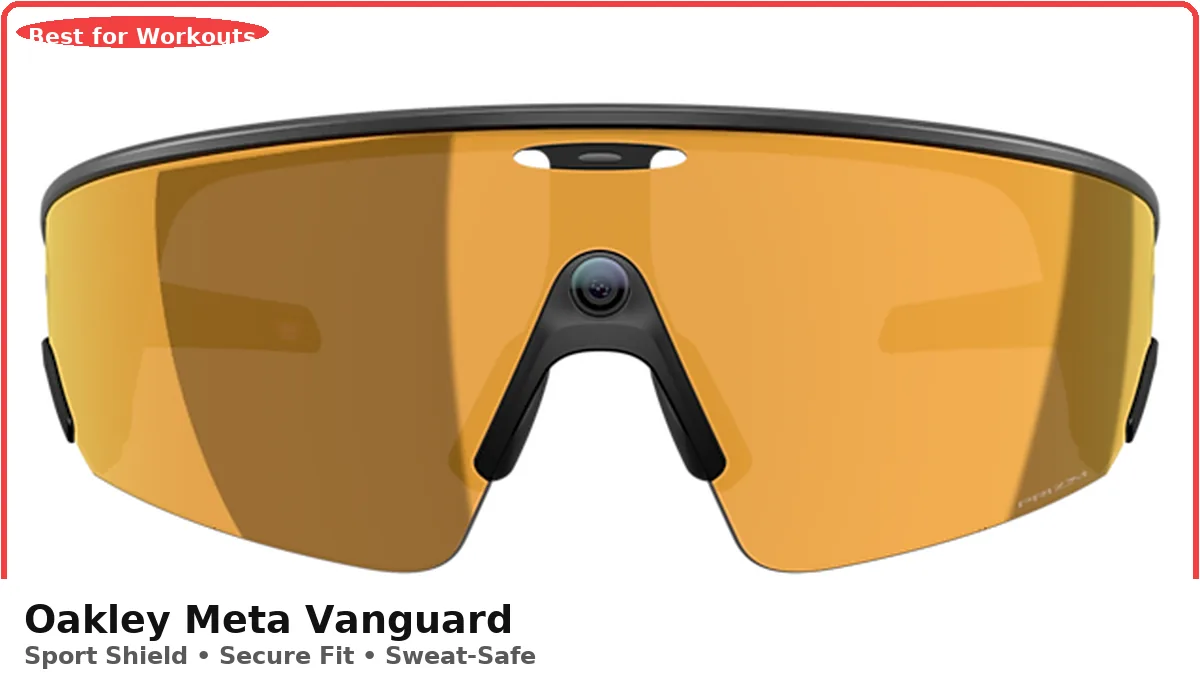
Oakley Meta Vanguard
- Doesn’t bounce running
- Wide awareness
- One-hand controls
- Premium pricing
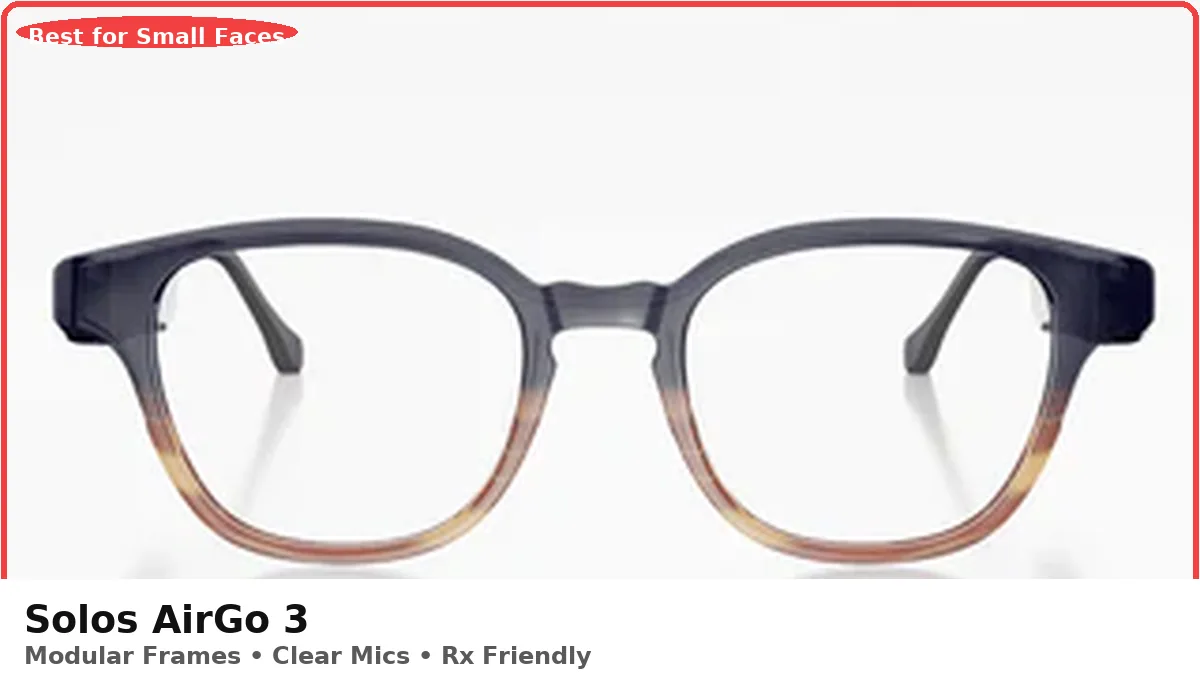
Solos AirGo 3
- Narrow fit options
- Gesture remap app
- Comfortable temples
- Battery average
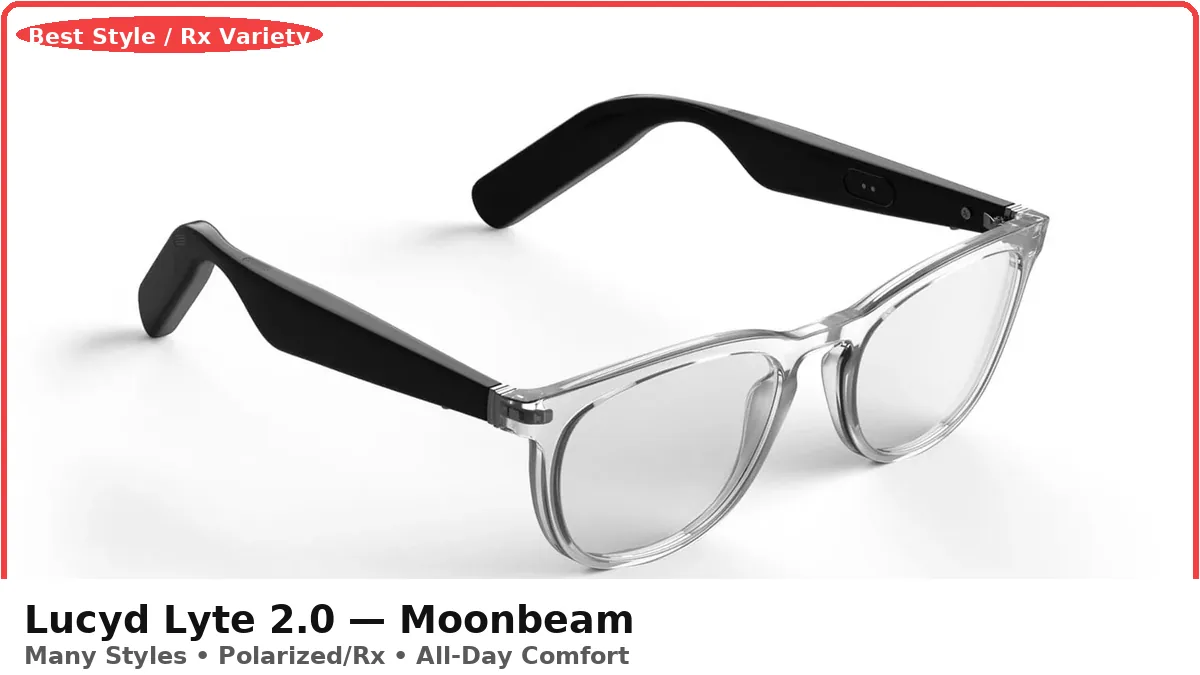
Lucyd Lyte 2.0 — Moonbeam
- Huge lens catalog
- Light & comfy
- Great Rx support
- Mic quality varies by model
Audio Glasses — Quick FAQs
Key Takeaways
- Audio glasses now mix open-ear audio, AR displays, and AI assistants — expect more functionality than basic Bluetooth eyewear.
- Best audio glasses Fall 2025 span budget to premium; top names include XReal One Pro, Ray-Ban Meta, Bose, and Amazon Echo Frames.
- Open-ear audio keeps you aware of surroundings but usually limits bass compared with earbuds.
- AI features vary: some glasses run native assistants, others rely on your phone — check mic quality and battery life.
- Pick by use case: commuting and calls favor mic performance; runners and bikers prioritize open-ear safety and fit.
Why You Should Care About Audio Glasses in Fall 2025
Hook: If you want hands-free audio frames that blend sound, style, and smarts, now is the moment to pay attention. The audio glasses benefits are no longer theoretical; they deliver clearer calls, steady music, and on-device AI that helps you get things done without reaching for a phone.
Why buy audio glasses 2025 instead of waiting? New models from Ray-Ban Meta, Bose, Amazon Echo, and XReal show major leaps in battery life, mic arrays, and comfort. These wearable audio devices are lighter and last longer, with several models reporting up to eight hours of use and USB-C charging for quick top-ups.
The shift from novelty to real utility stems from better microphones and smarter software. Call quality is improved by multi-mic beamforming and wind-noise rejection. That makes hands-free conversations more reliable when you walk, cycle, or commute.
AR-capable glasses such as XReal One Pro and enhanced AI features in Ray-Ban Meta prove that display and audio convergence matters. You get contextual prompts, object recognition, and on-device assistants that turn wearable audio devices into useful daily tools.
Why buy audio glasses 2025 if you value convenience? For many users, the appeal is clear: seamless voice control, discreet audio during calls, and simpler integration with apps like Alexa and Meta AI. These hands-free audio frames let you stay connected while keeping your phone tucked away.
AI audio glasses are changing expectations for companion apps and on-device processing. Native AI experiences reduce latency and protect privacy by handling more tasks locally. That adds up to a smoother, more responsive experience when you ask for directions, translations, or quick summaries.
The practical takeaway is straightforward: the audio glasses benefits you get this fall include improved call clarity, real AI features, longer battery life, and lighter builds. If you want wearable audio devices that fit into everyday life, this generation is worth a closer look.
Who Audio Glasses Are (and Aren’t) For
Audio glasses are perfect for those who wear glasses and dislike earbuds. They allow you to listen to podcasts and audiobooks while staying alert to your surroundings. The midrange vocal clarity makes spoken words clear without drowning out other sounds.
Before buying audio glasses, think about your needs. Commuters will find audio sunglasses useful for listening on public transport. Runners and cyclists will appreciate smart glasses that enhance safety and sound.
People who prefer frames over contacts and want fewer cables are good candidates. Audio glasses are great for those who value convenience. They’re perfect for staying connected without the need for earbuds.
Choose AI-first or camera-forward models if you value hands-free assistants. Ray-Ban Meta is ideal for those who want camera-assisted queries. Amazon Echo Frames are great for Alexa users who control smart devices with their voice.
Don’t get audio glasses if you’re a bass lover or an audiophile. Over-ear headphones or high-end earbuds are better for deep bass and a wider soundstage. If you need prescription lenses, check if the vendor offers Rx options or use Lensabl and other services.
How Open-Ear vs Bone-Conduction Works: Definitions and Trade-offs
Before choosing, understand how open-ear and bone-conduction systems work. This guide explains their functions, strengths, and what you sacrifice for safety, clear voice, or better music.
What open-ear audio is
Open-ear audio uses tiny drivers in the temple arms to direct sound to your ears. This keeps the ear canal open. Brands like Bose and Amazon use it for clear speech and podcasts.
This design offers clear voice and natural sound cues. But, it lacks bass because sound travels through air. Low frequencies spread out, making bass less intense.
What bone-conduction is
Bone-conduction glasses send vibrations through your cheekbones to your inner ear. They sit on the skin, not in your ear, so you stay aware of your surroundings.
The sound from these glasses might seem thin or lack bass. Brands like AfterShokz focus on safety for athletes who need to hear traffic.
When to pick each technology
Choose open-ear audio for clear voice and midrange. It’s great for calls and podcasts, keeping your ears open.
Opt for bone-conduction for safety. It’s better for athletes who need to hear their environment. You might get less music quality, but it’s worth it for awareness.
| Use case | Open-ear audio glasses | Bone-conduction audio glasses | Earbuds/headphones |
|---|---|---|---|
| Voice calls & podcasts | Clear midrange, strong vocal presence | Acceptable clarity, slightly thin voice | Best isolation and full-range sound |
| Music fidelity | Good highs and mids, limited bass | Thin sound, bass often lacking | Best bass and full-spectrum response |
| Situational awareness | Good awareness, some sound leakage | Maximized awareness, minimal ear occlusion | Poor awareness unless transparent mode used |
| Sports & cycling | Solid choice for urban commuting | Preferred for safety-focused activities | Not recommended for high-traffic outdoor use |
| Sound leakage to bystanders | Moderate, can be noticeable at higher volumes | Low to moderate, vibrations can be heard nearby | Minimal with in-ear seal |
Editor’s Reviews: Best Smart Audio Glasses (2025)
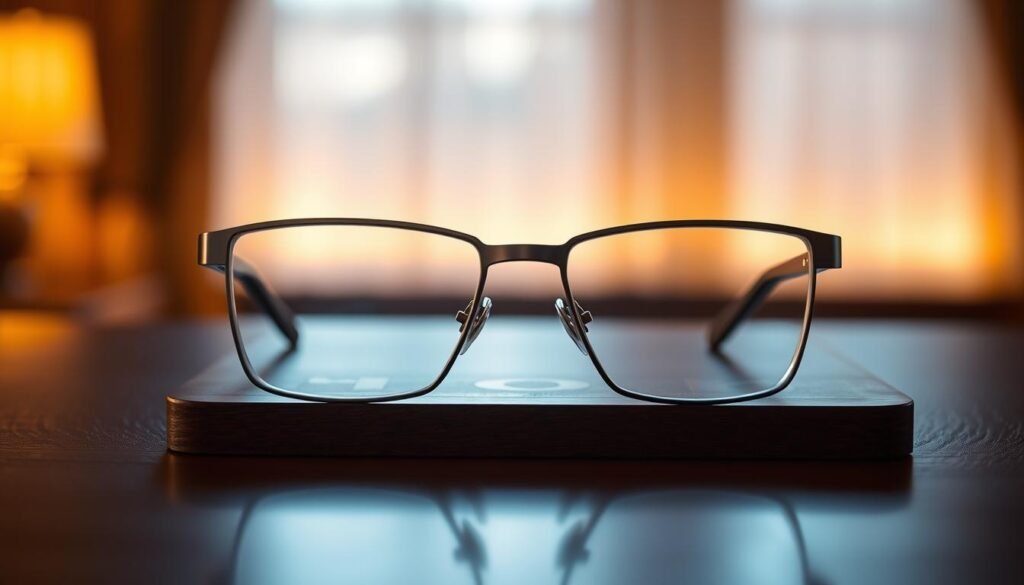
Quick, no-fluff verdicts for each pick—who it’s for, what we loved, and what to watch out for.
Alexa-First
Amazon Echo Frames (Newest Model)
Best for Alexa households and hands-free reminders, lists, and smart-home control.
- Voice pickup is dependable for timers, calls, and quick commands.
- Open-ear audio keeps you aware of your surroundings.
- Comfortable everyday styling with prescription-friendly frames.
- Seamless Alexa routines on the go
- Discreet look; lightweight fit
- Clear call quality for day-to-day use
- Audio lacks bass “thump” vs. earbuds
- Alexa-centric—less flexible without Amazon services
Best for Smart-Home Users
Verdict: If you live in the Alexa ecosystem, these feel like glasses that happen to be a wearable assistant—exactly the point.
Already in the Alexa world? Pair your setup with a smart soundbar or go truly mobile with earbuds with marathon battery life.
Details & Specs-Amazon Echo Frames
Modular
Soundcore Frames Wander
Best for style tinkerers who want interchangeable frames with solid everyday sound.
- Swap frame fronts to match outfits or occasions.
- Balanced open-audio for podcasts, calls, and casual music.
- Good value vs. premium rivals.
- Interchangeable fronts add longevity and fun
- Comfortable clamp pressure
- Reliable touch controls
- Wind noise can creep in outdoors
- Not the loudest for noisy commutes
Best Value Style-Swapper
Verdict: A flexible, fashion-friendly pick that nails the basics and keeps costs sensible.
On a value build? Check our longest-lasting Bluetooth speakers and all-day earbuds.
Details & Specs-Soundcore Frames
Camera + AI
Ray-Ban Meta Wayfarer (Polarized)
Best for creators who want iconic style with cameras, voice assistance, and share-ready content.
- Signature Wayfarer look with capable mics and speakers.
- Hands-free photo/video capture for moments and vlogs.
- Polarized lenses elevate outdoor wear.
- Top-tier design & comfort
- Clear calls; good voice pickup
- Compelling creator features
- Privacy concerns in camera-sensitive spaces
- Battery drains faster with capture
Best for Creators
Verdict: Fashion-forward smart glasses that finally make cameras feel natural—great for social-first users.
Level up your living room with a smart soundbar (Alexa/Google), or expand at home with multi-room speakers.
Details & Specs-Ray-Ban Meta
Sporty
Oakley Meta Vanguard
Best for active wear—sporty frame stability with open-ear awareness for runs and rides.
- Secure fit and durable build for workouts.
- Open-ear audio keeps traffic and trail cues audible.
- Oakley lens quality for sunny sessions.
- Grippy fit; sweat-friendly
- Outdoor-tuned clarity for voice & cues
- Brand-trusted optics
- Bolder look isn’t for everyone
- Audio focus is clarity, not heavy bass
Best for Fitness & Commutes
Verdict: A strong pick if you want safer, soundtrack-enabled training without sealing your ears.
Training day? Swap to sweatproof workout headphones, or keep a pocket backup with long-battery earbuds.
Details & Specs-Oakley Meta
Work/Calls
Solos AirGo 3
Best for hybrid workers—excellent mic pickup, modular temples, and productivity-leaning features.
- Very clear call quality and reliable noise pickup.
- Modular temple system enables upgrades and repairs.
- Comfortable for long wear days.
- Call clarity stands out
- Swappable parts extend life
- Comfortable weight and balance
- Less “fashion” than lifestyle picks
- App learning curve for first-timers
Best for Calls & Productivity
Verdict: A quietly excellent work companion—if meetings matter more than music, start here.
For long calls and commutes, try earbuds that last all day; prefer gear that lasts? See our eco-friendly picks.
Details & Specs-Solos AirGo 3
Everyday
Lucyd Lyte – Moonbeam
Best for prescription wearers who want a clean, everyday look with easy listening and calls.
- Prescription-friendly frames with simple setup.
- Lightweight design suits full-day wear.
- Solid for podcasts, audiobooks, and casual tunes.
- Comfortable, understated styling
- Good mic for indoor calls
- Often more affordable than camera-equipped rivals
- Not aimed at creators—no cameras
- Audio presence is modest vs. premium sets
Best for Prescription Users
Verdict: A friendly entry point into audio glasses—simple, comfortable, and easy to wear anywhere.
Daily wear, simplified—add all-day earbuds for travel and check our durable, eco-friendly gear.
Details & Specs-Lucyd Lyte
Sound Quality & Microphones
Most audio glasses offer clear vocals and good detail in the midrange. Open-ear designs and small drivers mean less bass. So, tracks with heavy low-end sound thin compared to earbuds.
High volumes can make sounds hollow and introduce distortion. It’s best to keep the volume moderate for better sound and less leakage.
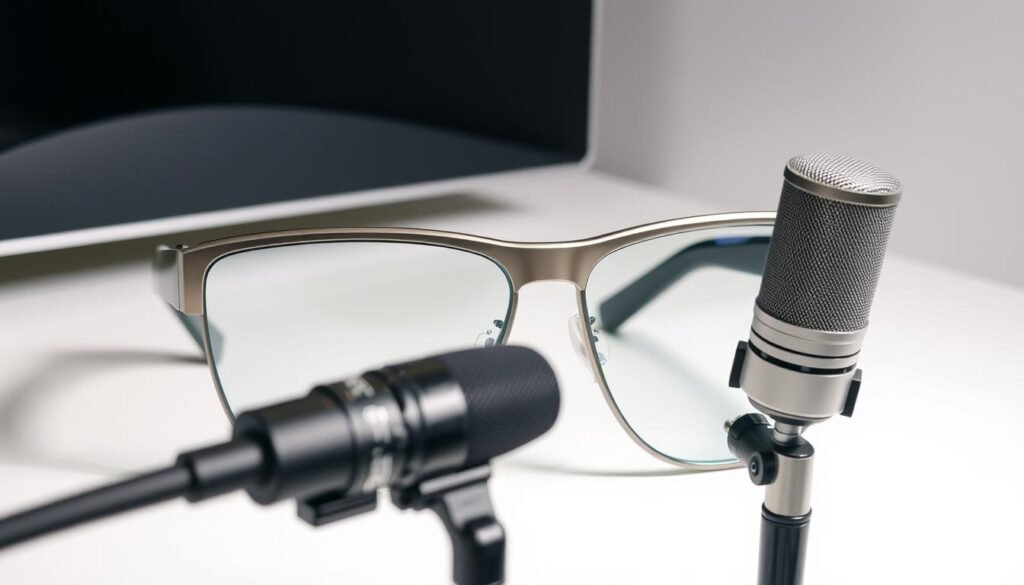
What you can realistically expect
Audio glasses work great for podcasts, audiobooks, and phone calls. They make voices clear, which is helpful when walking or commuting. But, they might not deliver the deep bass or studio-quality sound that music fans crave.
Using a phone equalizer or choosing frames with stronger drivers can help bridge the gap. This can improve the sound quality.
Leakage is a problem at high volumes. It’s best to keep the volume down in public to avoid disturbing others. Some models have foam tips or directional drivers to reduce spill. But, no open-ear pair is fully private at high volume.
Microphone tech and call expectations
Microphone arrays and beamforming help capture your voice while filtering out background noise. Brands like Bose and Amazon use dual-microphone arrays and adaptive processing for clearer calls. Soundcore and Razer also use multi-mic setups, but with varying success in wind suppression and latency.
In everyday use, modern audio glasses microphones handle calls and voice assistants well. They offer call quality that rivals many earbuds. But, they struggle with heavy wind or very noisy streets. For recording podcasts or professional voice work, dedicated mics are better.
| Category | Typical Strength | Typical Limitation | Representative Brands |
|---|---|---|---|
| Speech clarity | High for midrange and vocals | Can be affected by wind and traffic | Bose, Amazon Echo Frames, Soundcore |
| Music fidelity | Good for voice-led tracks | Limited bass and soundstage vs earbuds | Bose Frames, Ray-Ban Meta, XReal |
| Microphone tech | Beamforming and dual mic arrays common | Variable wind suppression and noise gating | Bose (dual beamforming), Amazon (Echo Frames), Razer |
| Bluetooth behavior | Stable connections for calls and streaming | Latency may affect gaming or video sync | Most modern models; check codec support |
| Sound leakage | Low at moderate volumes | Noticeable at high volumes | Bose, Ray-Ban, Echo Frames |
Call Quality & Wind-Noise Tests
When judging call quality in audio glasses, clear rules are essential. We use lab tests and real-world checks. This way, you know how they perform during daily activities.
How we evaluate calls
We test calls in quiet rooms and noisy areas to see how clear they are. In the lab, we look at signal-to-noise ratio and how well the mic picks up sound. We also check latency and how well they block out background noise.
Then, we test them in real-world conditions, like cycling or running. We use real voices and recorded prompts. This shows how they handle different types of speech and sudden noises.
What to look for in specs and tests
Look for dual beamforming microphones and wind-noise suppression in specs. Multiple microphones help block out background noise. Brands like Bose and Amazon highlight call quality improvements in their models.
In a call test, check the mic array design and wind handling. Real-world results can differ from what specs say. Look at both SNR numbers and what people say about the sound quality.
Wind is a big challenge for open-ear designs. The shape of the frame and helmet-friendliness can help. If you plan to cycle or run, choose models that passed wind tests at high speeds.
| Test | Metric | What it reveals |
|---|---|---|
| Quiet-room call | SNR, latency | Baseline clarity and responsiveness for voice assistants |
| Noisy café | Intelligibility score, subjective rating | How well beamforming microphones isolate your voice |
| Wind tunnel / outdoor | Wind masking (dB), caller comprehension | Real-world wind-noise suppression and frame effects |
| Motion test (bike/run) | Dropouts, handling of transient noise | Performance under movement and wind shear |
Comfort, Fit, Controls, Weight & Pressure Points
Choosing audio eyewear is more than just sound quality. You must consider comfort and fit for long days. The design, nose pads, temple stiffness, and weight all affect how you feel.
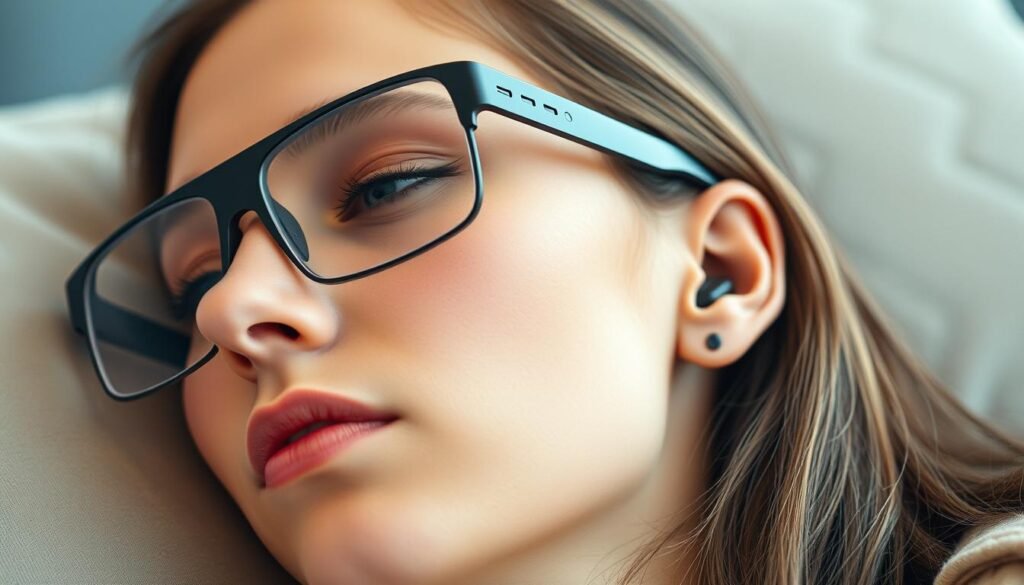
Look for frames that offer adjustable nose pieces or flexible temples. Brands like Bose and Ray-Ban Meta have stable temples that prevent slipping. Try glasses with your helmet or while running to ensure they fit well.
The weight of glasses is important, but not just the grams. Echo Frames weigh 37–46g, while AR devices like XReal One Pro can be up to 87g. Lighter models, like Razer Anzu (43–48g), are easier to wear all day. Heavier models may fit better but can cause pressure.
Test glasses for temple and nose-bridge pressure. Rimless or thin-rim designs distribute weight differently than full-rim frames. Some budget brands may cause discomfort after a while. Look for flexible hinges and soft silicone nose pads to avoid pressure points.
Controls affect how you use your device. You can choose from tap swipe voice controls or mechanical buttons. Razer Anzu and Soundcore use touch sensors on temple arms. These are easy to use but can be triggered by adjusting your glasses.
Mechanical buttons are found on Amazon Echo Frames and some XReal units. They offer tactile feedback and are reliable, even in windy conditions. Voice activation is common on Ray-Ban Meta and Echo Frames for hands-free use. Voice commands work well for quick tasks but depend on the assistant’s response and battery level.
Consider both comfort and control reliability. If you prefer tap swipe controls, choose a model with accurate sensors or customizable gestures. For minimal interaction, focus on responsive voice assistants and low false positives.
| Comfort Factor | What to Check | Example Brands/Notes |
|---|---|---|
| Weight | Compare grams and test for long-wear comfort | Echo Frames ~37–46g; XReal One Pro ~87g; Razer Anzu 43–48g |
| Nose Fit | Multiple nose-piece sizes or soft pads reduce bridge pressure | Avantree-like replaceable pads improve fit for varied noses |
| Temple Design | Flexible arms and hinge tension affect slippage and pressure | Bose and Ray-Ban Meta use sturdier temples for active use |
| Control Style | Tap, swipe, mechanical buttons, or voice — test for false triggers | Razer Anzu/Soundcore (touch); Echo Frames/XReal (buttons); Ray-Ban Meta (voice) |
| Pressure Points | Assess temple and bridge hotspots during 1–3 hour wear | Rimless frames may concentrate pressure; soft pads help |
| Hands-Free Use | Voice assistant reliability and battery life for hands-free audio frames | Echo Frames and Ray-Ban Meta excel with Alexa and Meta/assistant support |
Frames, Lenses, Polarization & Rx Options
Choosing the right frames and lenses is key for audio eyewear. Frames affect how well the speakers fit and sound. Lenses control glare, protect your eyes, and can be made for prescription needs.
Many brands let you turn standard models into Rx audio eyewear. Services like Lensabl, ReplacerXLenses, or overnightglasses can help. Bose Frames and Amazon Echo Frames often accept prescription inserts or factory-fitted lenses. But, models from XReal and Viture might need special inserts and may not be Rx-friendly without add-ons.
Lens choices vary by model. You can pick clear lenses for indoor use, blue-light filtering for long screen sessions, tinted lenses for casual sun protection, and polarized audio sunglasses for strong glare reduction. Razer Anzu offers swap-in polarized and blue-light options. Prices for optional lenses typically range from $39 to $100, depending on coatings and markings.
Polarized audio sunglasses are best for water, snow, or reflective pavement. They cut horizontal glare and make driving or boating safer. Clear or blue-light lenses are better for indoor work or tasks needing clear visual clarity.
Rx audio eyewear solutions include factory-installed lenses and aftermarket conversions. Factory-installed Rx options keep warranty coverage. Aftermarket providers offer fast turnarounds and a wide variety of lens options, including high-index and progressive lenses.
Smart lens options smart glasses often include anti-reflective coatings and photochromic tints for light-adaptive behavior. Electrochromic dimmable lenses exist for dynamic tint control, but these are rare in audio-first frames and may lack easy Rx compatibility.
| Feature | Who it’s for | Typical cost | Notes |
|---|---|---|---|
| Clear lenses | Office use, screen work | $0–$50 | Can add blue-light coating; easiest to fit with Rx audio eyewear |
| Blue-light filtering | Frequent computer users | $20–$80 | Reduces eye strain; available as Rx or swap-in for many brands |
| Polarized audio sunglasses | Drivers, outdoor sports | $50–$150 | Excellent glare reduction; look for polarized sunglass lenses audio glasses from Bose or Razer |
| Photochromic lenses | Mixed indoor/outdoor use | $70–$200 | Auto-darken in sunlight; good for variable light but slower than polarized for glare |
| Electrochromic dimmable | High-end commuters, tech enthusiasts | $200+ | Dynamic tint control; limited Rx support in audio-first models |
| Factory Rx fit | People who want warranty-covered prescriptions | $75–$200 | Often available from major brands or authorized dealers |
| Aftermarket Rx conversion | Those who want fast, flexible lens options | $39–$120 | Wide lens selection; use reputable services for proper speaker alignment |
AI Assistants & Companion Apps
AI features and companion apps change how you use audio eyewear every day. Some models have native assistants built into the frames. Others need your phone for voice control, updates, and advanced settings.
Which devices run AI on the glasses and which rely on the phone
Ray-Ban Meta has Meta AI right in the frames. It offers on-device prompts and camera-assisted queries. Amazon’s Echo Frames include Alexa for hands-free smart home control and quick voice replies.
Lucyd’s ChatGPT glasses pair an LLM with the frames for conversational answers. Some features come to iOS first, and Android support can be late. Many smart glasses with speakers use your phone’s voice assistants via Bluetooth.
Companion app features to expect
Your companion app is the hub for audio eyewear. It offers firmware updates, EQ presets, and low-latency modes. These improve sync for video and gaming.
Camera-enabled models have lens selection, camera settings, and privacy toggles. Apps from Ray-Ban and Lucyd expose camera controls and AI prompts. Anker and Soundcore apps focus on firmware and EQ adjustments. Razer Anzu’s app adds latency and sound tuning for gamers.
Platform limits and real-world compatibility
Check OS compatibility before buying. ChatGPT glasses may start on iOS, with Android features limited. Meta AI on Ray-Ban uses the camera for richer context, needing app permissions and up-to-date firmware.
Echo Frames Alexa works well across platforms but benefits from the Alexa app for routines and smart-home setup.
| Feature | Meta AI glasses (Ray-Ban) | Echo Frames Alexa | ChatGPT glasses (Lucyd) | Phone-dependent smart glasses with speakers |
|---|---|---|---|---|
| Native on-device AI | Yes — Meta AI, camera-assisted | Yes — Alexa built in | Yes — ChatGPT integration (iOS-first) | No — uses Siri/Google Assistant via phone |
| Companion app EQ | Yes — EQ and camera controls | Yes — Alexa settings and routines | Yes — AI settings and prompts | Varies — many provide EQ and firmware |
| Firmware updates via app | Yes | Yes | Yes | Yes |
| Low-latency / gaming mode | Limited — app-dependent | Not primary focus | Limited — dependent on pairing | Often available in brand apps |
| Camera-assisted context | Yes — uses camera for queries | No — voice-first | Possible — app-dependent | No |
| OS restrictions to watch | iOS/Android features may differ | Works across platforms with Alexa app | iOS-first for some features | Performance varies by phone model |
Battery, Charging & Cases
If you plan to wear audio glasses all day, battery basics are key. Audio glasses can last from four hours for small models to eight hours or more for sporty designs. It’s important to look at real-world battery life. For example, Echo Frames usually last about 4 hours, while Ray-Ban Meta models also last around 4 hours. Bose Tempo can go up to 8 hours, and Revo Sonic 1 can reach 11 hours on a single charge.
Charging options affect how portable your audio glasses are. Some use usb-c chargers for quick, universal charging. Others stick to pogo-pin charging or magnetic docks. Amazon Echo Frames, for instance, used pogo-pin charging, which some found inconvenient.
Think about how you’ll use your glasses daily. Volume, phone calls, and ambient noise modes can reduce battery life. If you travel a lot, look for glasses with long battery life and a charging case. For light commutes, a simple case might be enough.
Here are some tips to avoid battery issues. Make sure you know if your glasses use USB-C or a special cable. Test how fast a case can charge your glasses. Also, check if the case can charge the frames or if it’s just for protection.
Below is a quick comparison to help you weigh battery and charging trade-offs across current market leaders.
| Model | Typical Music Playtime | Charging Method | Case Charges Frames? |
|---|---|---|---|
| Amazon Echo Frames (Gen 3) | About 4 hours | Dock with pogo-pin charging | No, dock required but not always integrated |
| Ray-Ban Meta Smart Glasses | About 4 hours | Magnetic charger / proprietary cable | Protective case; charging depends on variant |
| Oakley Meta Vanguard | Up to 6 hours | Frames charge in a charging case; the case recharges via USB-C (case full in ~3.5h) | The charging case provides ~5 additional full charges for the frames |
| Solos AirGo 3 | About ~10 hours | USB-C cable directly to the glasses (no case) | No case; charges via USB-C cable. |
| Soundcore (select models) | Around 5.5 hours | Magnetic charger or usb-c depending on model | Some include charging case; check model details |
| Lucyd Lyte – Moonbeam | Up to ~12 hours | Proprietary magnetic cable that attaches to both temples (1.5h to full) | No charging case; optional desktop charging dock sold separately. |
Open-Ear Alternatives and When to Choose Them
Choosing between open-ear alternatives can be tricky. You need to think about sound quality, safety, and how aware you stay. This guide compares three options to help you choose the best for your day.
Bone-conduction audio sends sound through your cheekbones. This lets you stay aware of your surroundings. Brands like AfterShokz are popular for runners and cyclists. But, you might miss out on deep bass and rich sound compared to sealed headphones.
Open-ear driver glasses, like Bose Frames and Amazon Echo Frames, send sound to your ear without blocking it. They offer better midrange clarity than bone-conduction audio but might leak sound. Open-ear vs earbuds shows open-ear keeps you aware, while earbuds block out the world.
Earbuds are the best for sound quality. True wireless earbuds from Apple, Sony, and Sennheiser offer deep bass and clear sound. If you love music, earbuds are the best choice, even if they block out your surroundings.
Below is a compact comparison to highlight core differences and real-world fit.
| Feature | Open-Ear Driver Glasses | Bone-Conduction Headphones | Earbuds / Headphones |
|---|---|---|---|
| Situational Awareness | High — ear canal open | Very high — bone path, ears open | Low — isolates sound |
| Sound Quality | Good for voice, moderate music | Poorer bass, ok for calls | Excellent, best for music |
| Sound Leakage | Moderate — noticeable at high volumes | Low to moderate — less directional | Minimal when sealed |
| Best Use Case | Commuting, spoken-word media, multitasking | Outdoor running, cycling, safety-first users | Home listening, flights, audiophiles |
| Typical Brands | Bose Frames, Amazon Echo Frames | AfterShokz (Shokz) | Apple AirPods, Sony WF-1000XM5 |
When deciding between earbuds and audio glasses, think about where you’ll use them. Open-ear driver glasses are great for commuters and office workers. They offer clear voice and safety. Bone-conduction headphones are safer for runners and cyclists who need to hear their surroundings.
If you prioritize music quality and immersive sound, go for earbuds or over-ear headphones. Open-ear alternatives like audio glasses and bone-conduction audio are good for safety and convenience. But, they might not offer the best bass and full-range clarity.
Use these guidelines to find the right device for your daily routines. Choose the one that balances audio needs with safety and comfort for your lifestyle.
Buyer’s Guide — What Matters Most When Buying Audio Glasses
Choosing the right pair of audio glasses starts with knowing how you plan to use them. Do you want AI features, AR display, or powerful sound for running? Or maybe you’re looking for something to control your smart home or a budget option for everyday listening? Your choice will narrow down quickly once you decide what’s most important to you. This guide will help you make the right decision.
How to buy audio glasses depends on matching features to your needs. For AI and style, Ray-Ban Meta is a top choice. XReal One Pro is great for AR visuals and spatial audio. Bose Frames Tempo is perfect for sports and clear calls. Amazon Echo Frames are ideal for Alexa and smart-home control. Razer Anzu and other budget options are good for those who value low cost and latency.
Next, consider the key factors. Sound quality is important for a good listening experience. The microphone’s performance affects call clarity and outdoor use. Battery life ensures your glasses last all day. Fit and weight are essential for comfort. Lens and prescription options are important if you need glasses.
Controls and connectivity are also important. Tap controls are quick but can be accidental. Voice control is great for hands-free use. App and firmware support keep your glasses updated and fix bugs.
Price varies a lot. Basic frames start at $30, while smart sunglasses cost $150–$300. AR-enabled glasses are over $600. Adding prescription lenses or replacements can add $100–$200. Remember to include these costs when comparing models.
How We Test Audio Glasses
We mix lab tests with real-world checks in our reviews. This ensures our results are fair and consistent. We test models from Ray-Ban Meta, Bose, and others to give you clear insights.
Methodology overview
We first check the glasses’ fit and feel. We weigh them, test comfort for 30 minutes, and check how they fit different faces. This helps us spot any comfort issues that show up after wearing them for a while.
Next, we test battery life. We use a stopwatch and play music at different volumes until the battery runs out. This shows how long the glasses last and how volume affects battery life.
We measure audio quality and leakage with special tools and tracks. We focus on vocals, mids, and bass to compare sound quality. We also take subjective notes to help you understand the sound quality better.
For mic and call tests, we use voice recordings and make live calls. We test in quiet rooms, cafes, and simulate wind at cycling speeds. This shows how well the glasses handle speech and wind noise.
Latency tests are important for video and gaming. We check how well audio syncs with video to measure delay in milliseconds. Low latency is key for smooth video and gaming experiences.
We also test app and AI features. We check how well the AI assistant works, what the app offers, and if updates improve performance. This helps us see how useful these features are.
Durability tests include checking for water resistance, drop tests, and repeated button presses. We also check the charging case for fit and port lifespan. This helps us spot any long-term issues.
We test lens and Rx compatibility to see if the glasses fit your prescription needs. This ensures you know if the glasses will work for you before you buy them.
We combine lab tests with real-world use to get a complete picture. This mix of lab data and real-world testing is the core of our review process.
| Test Area | Tools & Metrics | What We Record |
|---|---|---|
| Fit & Comfort | Precision scale, 30‑minute wear trials | Weight (g), pressure points, fit notes for face shapes |
| Battery Life | Stopwatch, defined playlists at moderate/high volume | Runtime (hours), performance drop vs volume |
| Audio Quality | SPL meter, reference tracks, subjective notes | Frequency balance, leakage dB, tonal character |
| Microphone & Calls | Standardized voice recordings, live call scenarios | Clarity, SNR, wind handling at cycling speeds |
| Latency | Video sync tests, gaming cues | Delay in ms, lip‑sync and input lag notes |
| AI & App | Feature checklist, firmware update logs | Assistant response, app features, update impact |
| Durability & Water | IP rating checks, drop and control cycle tests | Ingress resistance, physical wear, control reliability |
| Lens & Rx | Prescription compatibility tests, polarization checks | Rx fit options, polar lens performance, fitting notes |
This detailed process is the foundation of our audio glasses testing. It ensures fair and consistent comparisons across brands.
Conclusion
To sum up, think about how you’ll use your audio glasses. If you want AR visuals and sound, the XReal One Pro is great for mixed-reality users (~$649). For AI and style, Ray-Ban Meta Smart Glasses offer Meta AI “Look and Ask” in a classic frame ($299–$329).
For sound-focused listening and clear calls, Bose Frames Tempo and Tenor/Soprano are top choices for sports and daily wear. Tempo lasts ~8 hours, while Tenor/Soprano lasts ~5–5.5 hours.
When picking audio glasses, consider what you need most. Whether it’s AI, AR, sports, commuting, or just music, each model has its strengths. Make sure they fit your prescription and are easy to charge.
Open-ear and bone-conduction designs are great for hands-free listening but might not be as good for music. They’re perfect for voice commands and staying aware of your surroundings.
The latest audio glasses for Fall 2025 bring smarter assistants, better mics, and stronger AR. You might have to give up a bit of sound quality compared to headphones. But, the right pair can enhance your daily life.

